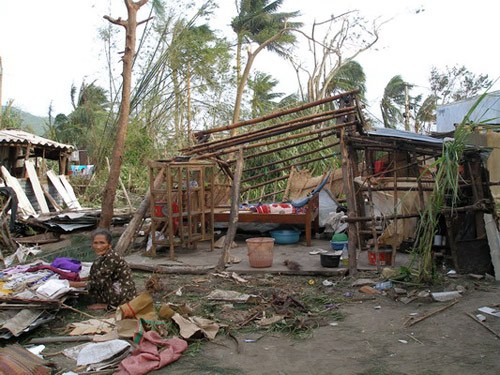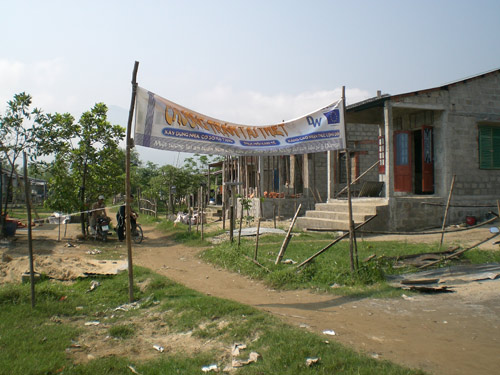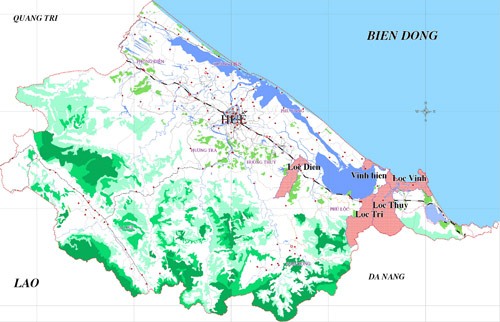| home |
Projects
ECHO Xangsane Reconstruction

Rebuilding a safer future for families affected by cyclone N° 6 Xangsane in central Viet Nam
In October 2006, cyclone N° 6, Xangsane, caused huge damage to the 3 central provinces of Vietnam, Thua Thien Hue, Danang City and Quang Nam.

One can assess the damage in terms of large economic loss, but in reality the people who were really vulnerable to this typhoon are the poor families living in hazard risk areas. Although receiving some support from authorities, these families are essentially left to cope using their own meagre resources in the aftermath of the disaster.
When a family’s home is damaged or destroyed, the loss and cost of recovery represents a major setback that puts or keeps the family below the poverty line, with far reaching consequences on their ability to survive and develop, to stay healthy, to educate their children and to earn a decent living. These people are extremely poor, but they make a huge effort to improve their circumstances. For the majority, the quality of their home – or indeed its fragility and poverty – is a defining condition that can keep a family living in constant vulnerability.
At a collective level for the communes in the same area, the same problem of weak and exposed buildings exists - schools, markets and health posts - are all at high risk of destruction, and when destruction takes place, the replacement cost of these buildings is extremely high.
The impact of typhoon N° 6 Xangsane (Category 3-4) which hit central Viet Nam on the 1st October 2006 highlights two important points.
- On the one hand, the intense preparation effort over the preceding 2-3 days, leading to a massive displacement of vulnerable people (about 300 000) to safe area-buildings, so there were very few mortalities (about 60 victims).
- On the other hand, damage and consequent economic loss were huge in Danang City, Thua Thien Hue and Quang Nam Provinces has been considerable : 25 000 houses destroyed, 300 000 unroofed and damaged, with losses amounting to 650 Million $. In the communes of Thua Thien Hué, the losses for private long term investment in fishery, aquaculture, and tree plantation are very high.
After the typhoon, the immediate response (repair infrastructure, food, water, medical care…) was excellent, but very little response for medium-long term has been proposed to families who have suffered as a result of the typhoon. In the area most affected in Thua Thien Hue (coastal communes of Phu Loc District) the damage to housing resulted mainly from the failure to respect the basic principles on cyclone resistant construction, and in many cases because poor quality roofing materials had been used. In the communes where DWF has been working, the houses, whether reinforced or new, built with DWF help that were visited after the cyclone have been safe, and constitute a very good example of what can and should be done.
On the 17th October 2006, the Thua Thien Hué Provincial People’s Committee issued a recommendation to all Districts and Organisation to apply the 10 principles of cyclone resistant construction techniques that have been introduced by the DWF project.
Following visits to the area by ECHO (European Commission Humanitarian Aid) field staff on October 2006, ECHO agreed to support a DWF programme to support families to
rebuild their homes and lives after the typhoon, and DWF activities in Thua Thien Hue Province started at the end of the year, and will continue through to mid May 2006.
220 families will receive support from the project, families whose life was seriously affected by the typhoon Xangsane and which caused the total or partial destruction of their home and the loss of most of their belongings and economic assets. They are mainly fishermen communities living along the sea to the east of the Cau Hai lagoon or on the inland western shore of the lagoon. Their economic activity ties them to these exposed locations.
As well as direct support to families, the project is also strengthening and repairing essential infrastructure, including a primary school and a safe harbour. 250 builders and cadres of the communes are also receiving training about safer housing.
Throughout the project, DWF is undertaking awareness raising actions to draw attention to the need for safe construction. The whole project is based on the active participation of involved families and community leaders alike.
